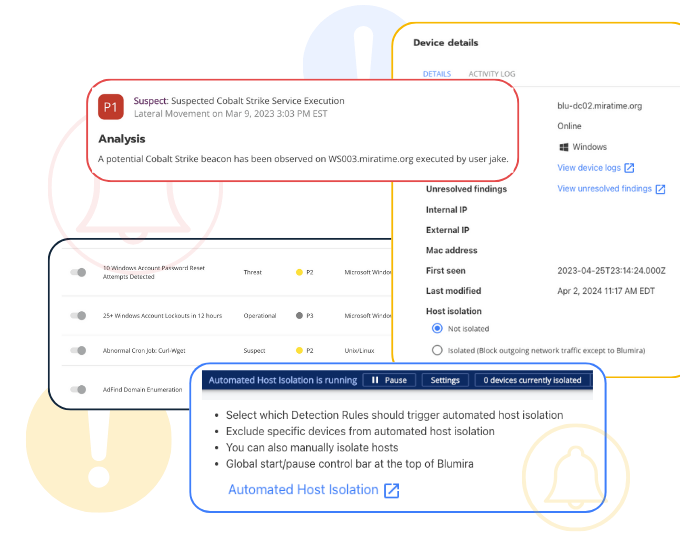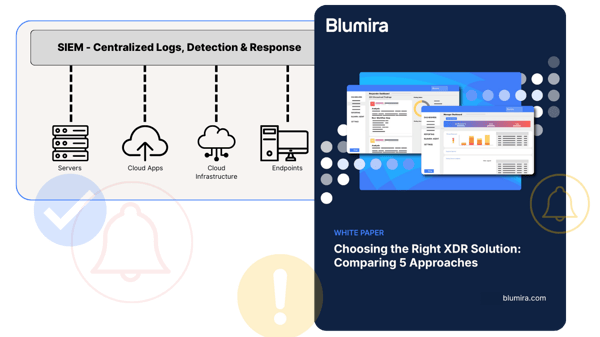
XDR Solution for SMBs
Blumira’s XDR solution helps SMBs detect and respond to threats faster by analyzing all security data in one place, free of complexity and high costs.
Demystify your digital defense and stay a step ahead — all while keeping compliance in check.
What Sets Our XDR Solution Apart?
Discover the unique blend of simplicity, power, and adaptability that elevates our XDR security platform above the rest.
Easy, Effective Security Stack
We deliver enhanced cybersecurity with our suite of protection without requiring in-house resources.
-
Managed SIEM
Start With Cloud Workload SIEM
Free up your team’s time with Blumira’s cloud SIEM, with detection rules managed by our security engineers and supported by our security engineers.
- Easy integration setup,
- pre-tuned to filter noisy alerts,
- one year of data retention to meet compliance,
- and reporting insights and visualizations for threat intelligence.
-
Endpoint Monitoring
Layer in Endpoint Visibility
Deploy Blumira Agent in minutes to get security insight into Windows, MAC, and Linux endpoints located anywhere – this lightweight endpoint agent requires no additional infrastructure to work.
Easy to deploy in minutes, Blumira Agent, is tailored for real-time threat detection and mitigation.
-
Security Automation
Add Automated Response
Block threats immediately -- Blumira Agent automatically isolates an endpoint from your network when a critical threat is identified and blocks traffic from known malicious IP addresses with Automated Blocking (for Dynamic Blocklists). -
Honeypots
Honeypots
Trap threat actors looking to make lateral movements. Blumira enables you to effortlessly deploy and manage decoy data, or honeypots. -
Playbooks
Playbooks
To streamline the threat detection and response process, Blumira’s security team has designed pre-defined procedures that guide your team through remediation and response – no need for security expertise. They make it simple for you with one click. -
SecOps Support
Security Operations Center (SOC) SecOps Support
24/7 SecOps support for critical alerts means you're never alone. Our experts are here to bring you customized support that solves your problems.
Start With Cloud Workload SIEM
Free up your team’s time with Blumira’s cloud SIEM, with detection rules managed by our security engineers and supported by our security engineers.
- Easy integration setup,
- pre-tuned to filter noisy alerts,
- one year of data retention to meet compliance,
- and reporting insights and visualizations for threat intelligence.
Layer in Endpoint Visibility
Deploy Blumira Agent in minutes to get security insight into Windows, MAC, and Linux endpoints located anywhere – this lightweight endpoint agent requires no additional infrastructure to work.
Easy to deploy in minutes, Blumira Agent, is tailored for real-time threat detection and mitigation.
Add Automated Response
Block threats immediately -- Blumira Agent automatically isolates an endpoint from your network when a critical threat is identified and blocks traffic from known malicious IP addresses with Automated Blocking (for Dynamic Blocklists).Honeypots
Trap threat actors looking to make lateral movements. Blumira enables you to effortlessly deploy and manage decoy data, or honeypots.Playbooks
To streamline the threat detection and response process, Blumira’s security team has designed pre-defined procedures that guide your team through remediation and response – no need for security expertise. They make it simple for you with one click.Security Operations Center (SOC) SecOps Support
24/7 SecOps support for critical alerts means you're never alone. Our experts are here to bring you customized support that solves your problems.The Product You Need. The Support You Deserve

Supercharge Your Defense with XDR
Dive into our whitepaper to explore how XDR revolutionizes your cybersecurity strategy. We unlock behavioral analytics, superior detection, seamless investigations, and unmatched rapid response. Empower your organization with the knowledge to outsmart threats and safeguard your digital landscape.
Read the WhitepaperIn Their Own Words
Hear directly from our partners and customers about how Blumira has transformed their cybersecurity posture.
“I told my director it’s like adding another employee, except much cheaper. That was a major driver — that Blumira was going to be taking care of the solution.”
Les Neely
System Admin, Upward Sports
“Being able to send logs from clients, servers, network equipment and cloud sources is very important. Knowing what is going on at all times and being alerted to something occurring allows us to look into who did what, when, and respond very quickly.”
Khan H.
Network Engineer, Mid-Market Transportation Company
“Blumira reduces the number of security staff required to monitor firewall, antivirus, shared drives, infrastructure configs and overall change management. We're alerted to only the important/critical alerts and there are actually useful information guides to walk you through resolutions.”
System Administrator
Mid-Marketing Education Management Company
Read up on the Latest Insights
View More
How our SIEM Playbooks Guide You Through Threat Response
Read MoreManual vs Automated Security Visibility for Resource-Constrained Teams
Read More
What is Unified Visibility and What Does it Offer?
Read MoreTry Blumira XDR Free For 30 Days
Step into the future of cybersecurity with Blumira XDR platform. Experience unmatched protection and simplicity today. No credit card required.